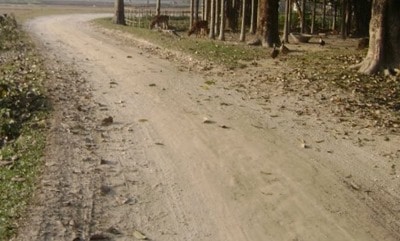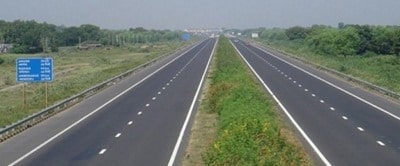Classification of Roads and Their Details
Road transportation is an essential network for any country. Classification of roads based on many factors such as materials, locations, traffic etc. are discussed.
Classification or Types of Roads
The roads are classified based on many factors as follows.
- Materials
- Location & function
- Traffic volume
- Width
- Economy
- Traffic type
- Rigidity
- Topography
Types of Roads Based on Materials
- Earthen roads
- Gravel roads
- Murrum roads
- Kankar roads
- WBM roads
- Bituminous roads
- Concrete roads
Earthen Roads
Earthen roads are laid with soil. They are cheaper of all types of roads. This type of road is provided for less traffic areas and or for countryside areas. Good drainage system should be required which reflects good performance for longer period.

Gravel Roads
Gravel roads are also low quality roads but they are good when compared to earthen roads. Compacted mixture of gravel and earth is used as pavement material in this case.

Murrum Roads
Murrum is a matter obtained from the disintegration of igneous rocks by weathering agencies. This is used to make roads called as murrum roads.

Kankar Roads
Kankar is nothing but impure form of lime stone. Kankar roads are provided where lime is available in good quantity. These are also low quality and performance wise they are similar to gravel and murrum roads.

WBM Roads
Water Bound Macadam (WBM) roads contain crushed stone aggregate in its base course. The aggregates are spread on the surface and these are rolled after sprinkling water.
WBM roads provides better performance compared to earthen, gravel, murrum and kankar roads.
WBM roads are laid as layers about 10cm thickness of each layer. They are very rough and may disintegrate immediately under traffic.

Bituminous Roads
Bituminous roads are very popular roads around the world. They are most used roads in the world. They are low in cost and good for driving conditions. They are flexible and thickness of bituminous roads depends upon the subgrade soil conditions.

Concrete Roads
Cement concrete is used to construct the pavements in case of concrete roads. These are very popular and costlier than all other types of roads. They are not flexible so, they require less maintenance.
Concrete roads are suitable for high traffic areas. Concrete roads are laid with joints and time of construction is more.

Types of Roads Based on Location and Function
- National highways
- State highways
- District roads
- Rural roads or village roads
National Highways
National highways are main roads of a particular country. They connects all major cities to the capital of the country. They run throughout the length and breadth of the country. Minimum two lane road is provided for national highways.

State Highways
State highways are second main roads which connect major parts of state with in it. State highway ultimately connects to the national highways.

District Roads
District roads are provided with in the cities and connects markets and production places to state and national highways. Two types of district roads are there namely,
- Major district roads
- Minor district roads
Major district roads connect headquarters of neighboring district with main parts of district while minor district roads are laid with in the district.

Rural Roads or Village Roads
Village roads connects the nearby villages with each other. They lead to nearby town or district roads. Usually low quality roads are provided as village roads because of low traffic.

Types of Roads Based on Traffic Volume
- Light traffic roads
- Medium traffic roads
- High traffic roads
Light Traffic Roads
The roads which are carrying 400 vehicles daily on an average is called light traffic roads.
Medium Traffic Roads
If a road carrying 400 to 1000 vehicles per day then it is said to be medium traffic road.
High Traffic Roads
If a road is carrying is more than 1000 vehicles per day then it is considered as high traffic road.
Types of Roads Based on Economy
- Low cost roads
- Medium cost roads
- High cost roads
The economy depend upon the location and function of roads and also on the traffic analysis.
Types of Roads Based on Traffic Type
- Pedestrian ways
- Cycle tracks
- Motorways
Pedestrian Ways
Pedestrian ways are exclusively built for pedestrians and no vehicles are permitted in this way.
Cycle Tracks
Cycle tracks or bicycle tracks are provided on both sides of pavement for cyclists hence they can travel safely.
Motorways
Motorways are also known as expressways. Only few vehicles are accessible to use this type of roads. The vehicles which can move with high speed acceleration are permitted into this way. Motorways makes travel quick and provides comfort for high speed vehicles.
Types of Roads Based on Rigidity
- Flexible roads
- Rigid roads
Flexible Roads
Flexible roads consists flexible layer as pavement surface which require good maintenance otherwise it can be disintegrated easily with heavy traffic. All types of roads except concrete roads are come under this category.
Rigid Roads
Rigid pavements are non-flexible and cement concrete roads are come under this category.

Types of Roads Based on Topography
- Plain area road
- Hilly area roads
Plain Area Road
The roads constructed on leveled surface is known as plain area roads.
Hilly Area Roads
Roads constructed in hilly regions are called as hill area roads or ghat roads. Generally these are provided around the hill in spiral shape.

No comments:
Post a Comment